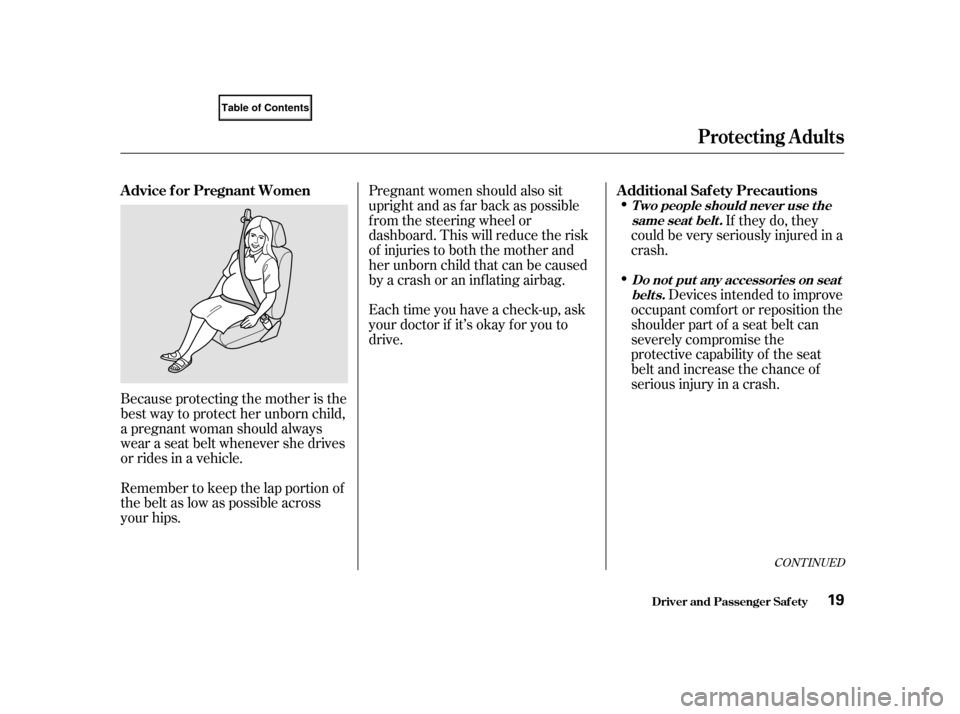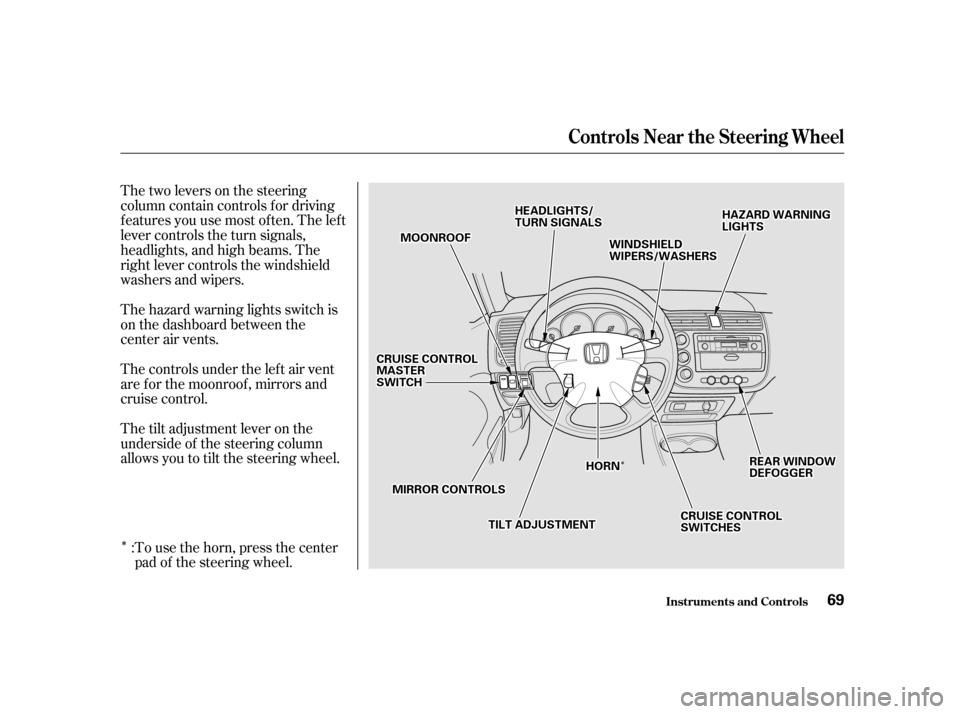Page 20 of 325
Adjust the steering wheel, if needed,
so that the wheel points toward your
chest, not toward your f ace.
Pointing the steering wheel toward
your chest provides optimal
protection f rom the airbag.
See page f or how to adjust the
steering wheel.
If a seat belt does not seem to work
as it should, it may not protect the
occupant in a crash.
Anyone using a seat belt that is
not working properly can be
seriously injured or killed. Have your
Honda dealer check the belt as soon
as possible.
See page f or additional
inf ormation about your seat belt
system and how to take care of your
belts.
This could cause
very serious injuries in a crash. 43
75
A djust the Steering Wheel
6.
No one should
sit in a seat wit h an inoperat ive seat belt.
Never place t he shoulder port ion of a lap/shoulder belt under your arm orbehind your back.
Protecting Adults
Driver and Passenger Saf ety17
Page 22 of 325

Because protecting the mother is the
best way to protect her unborn child,
a pregnant woman should always
wear a seat belt whenever she drives
or rides in a vehicle.
Remember to keep the lap portion of
the belt as low as possible across
your hips.Pregnant women should also sit
upright and as f ar back as possible
f rom the steering wheel or
dashboard. This will reduce the risk
of injuries to both the mother and
her unborn child that can be caused
by a crash or an inf lating airbag.
Each time you have a check-up, ask
your doctor if it’s okay f or you to
drive.
If they do, they
couldbeveryseriouslyinjuredina
crash.
Devices intended to improve
occupant comf ort or reposition the
shoulder part of a seat belt can
severely compromise the
protective capability of the seat
belt and increase the chance of
serious injury in a crash.
CONT INUED
Protecting Adults
Driver and Passenger Saf ety
Advice f or Pregnant Women Additional Saf ety Precautions
T wo people should never use t he
same seat belt .
Do not put any accessories on seatbelts.
19
Page 23 of 325

Carrying hard or sharp
objects on your lap, or driving with
a pipe or other sharp object in
your mouth, can result in injuries
if your f ront airbag inf lates.
Any object
attached to or placed on the covers
marked ‘‘SRS AIRBAG’’ in the
center of the steering wheel and
on top of the dashboard could
interf ere with the proper operation
of the airbags. Or, if the airbags
inf late, the objects could be
propelled inside the car and hurt
someone. If a side airbag
inflates,acupholderorotherhard
object attached on or near the
door could be propelled inside the
car and hurt someone.
If your
hands or arms are close to the
airbag cover in the center of the
steering wheel or on top of the
dashboard, they could be injured if
the f ront airbags inf late.
Protecting Adults
Driver and Passenger Saf ety
Do not place hard or sharp object s
bet ween yourself and a f rontairbag.
Do not at t ach or place object s onthe f ront airbag covers. On models wit h side airbags, do
not at t ach hard object s on or neara f ront door.
K eep your hands and arms awayf rom t he airbag covers.
20
Page 51 of 325

Your Supplemental Restraint System
(SRS) includes:Two f ront airbags. The driver’s
airbag is stored in the center of
the steering wheel; the f ront
passenger’sairbagisstoredinthe
dashboard. Both are marked ‘‘SRS
AIRBAG.’’
If you ever have a moderate to
severe f rontal collision, the sensors
will detect the vehicle’s rapid
deceleration. If the rate of
deceleration is high enough, the
control unit will instantly inf late the
f ront airbags.
A sophisticated electronic system
that continually monitors and
records inf ormation about the
sensors, the control unit, the
airbag activators, and driver and
passenger seat belt use when the
ignition is ON (II).
Sensors that can detect a
moderate to severe frontal
collision. Automatic seat belt tensioners
(see page ). An indicator light on the
instrument panel that alerts you to
a possible problem with the
system (see page ).
Emergency backup power in case
your car’s electrical system is
disconnected in a crash.
45
51
SRS Components
How Your Front A irbags Work
Additional Inf ormation About Your Airbags
Driver and Passenger Saf ety48
Page 60 of 325

This section gives inf ormation about
the controls and displays that
contribute to the daily operation of
your Honda. All the essential
controls are within easy reach............................
Control Locations .58
...............................
Indicator Lights .59
.............................................
Gauges .66
...............................
Speedometer .66
.................................
Tachometer .66 .....................................
Odometer .66
...................................
Trip Meter .67
..................................
Fuel Gauge .67
...................
Temperature Gauge . 68
Controls Near the Steering .......................................
Wheel .69
...................................
Headlights .70
............
Daytime Running Lights . 71
....
Instrument Panel Brightness . 71
................................
Turn Signals .72
.....................
Windshield Wipers .72
..................
Windshield Washers . 73
..........................
Hazard Warning .74
.............
Rear Window Def ogger . 74
......
Steering Wheel Adjustment . 75
...............
Steering Wheel Controls . 76
.............................
Cruise Control .76
...............................
Keys and Locks .79
..............................................
Keys .79
....................
Immobilizer System . 80
............................
Ignition Switch .82
..................................
Door Locks .83
......................
Power Door Locks .84
...................
Remote Transmitter . 85
...........................................
Trunk .88
........
Emergency Trunk Opener . 89............................
Seat Adjustments .90
.............
Front Seat Adjustments . 90
Driver’s Seat Height ..............................
Adjustment .91
................
Driver’s Seat Armrest . 91
........................
Rear Seat Access .91
..........................
Head Restraints .93
...........................
Folding Rear Seat .94
..............................
Power Windows .96
.........................................
Moonroof .98
.............................................
Mirrors .99
....
Adjusting the Power Mirrors . 99
...............................
Parking Brake .100
......................................
Glove Box .101
...........................
Beverage Holder .102
.................
Console Compartment . 102
........................................
Coin Box .103
...............................
Center Pocket .103
.............
Accessory Power Socket . 103
......................................
Coat Hook .104
.................................
Cargo Hooks .104
..................................
Cargo Net .104
...............................
Interior Lights .105
..............................
Ceiling Light .105
...................................
Spotlights .106
........................
Courtesy Lights .106
Instruments and Controls
Inst rument s and Cont rols57
Page 72 of 325

�Î
�Î
�Î
Thetwoleversonthesteering
column contain controls f or driving
f eatures you use most of ten. The lef t
lever controls the turn signals,
headlights, and high beams. The
right lever controls the windshield
washers and wipers.
The hazard warning lights switch is
on the dashboard between the
center air vents.
The controls under the lef t air vent
are f or the moonroof , mirrors and
cruise control.
The tilt adjustment lever on the
underside of the steering column
allows you to tilt the steering wheel.To use the horn, press the center
pad of the steering wheel.
:
Controls Near the Steering Wheel
Inst rument s and Cont rols69
H H
A
AZ
ZA
A R
RDD W
WA AR
RNNI INNG G
L
LI IGGH HT
TS
S
M
M O
OOONNRROOO OFF
T
TI
ILLT T A
AD
DJ
JUUS STTM
M E
EN
NT T W
WI
INND DS
SHH I
IEE L
LDD
W
WI IPP E
ER
RS S//W
WA AS
SHH E
ER
RS S
M
M I
IRRR ROOR R C
COON NTTR
RO OL LSS R
RE
EA
A R
R W
WI INND DO
OW W
D
D E
EF
FOOG GGGEER
R
H
H
E
EA
A D
DL
LIIGGH HT
TS
S/ /
T
T U
UR RNN S
SIIGGN NAAL
LSS
C
CRRUUI ISSE E C
COON NTTR
RO OL L
S
SW WI ITT C
CH H E
ES
S
C
CR
RUUI ISSE E C
COON NTTR
RO OL L
M
M A
AS
STTE
ER
R
S
SW WI ITT C
CH H
H
HO
OR RNN
Page 73 of 325
The rotating switch on the lef t lever
controls the lights. Turning this
switch to the ‘‘ ’’ position turns
on the parking lights, taillights,
instrument panel lights, side-marker
lights, and rear license plate lights.
Turning the switch to the ‘‘ ’’
position turns on the headlights.To change f rom low beams to high
beams, push the turn signal lever
f orward until you hear a click. The
blue high beam indicator will light
(see page ). To return to low
beams, pull the turn signal lever
back. If you leave the lights on with the
ignition switch in ACCESSORY (I)
or LOCK (0), you will hear a
reminder tone when you open the
driver’s door.
To f lash the high beams, pull the
turn signal lever back lightly, then
release it. The high beams will come
on and go of f . The high beams will
stay on f or as long as you hold the
lever back, no matter what position
the headlight switch is in.
63
Headlights
Controls Near the Steering Wheel
Inst rument s and Cont rols70
Page 74 of 325
Canadian models only
With the headlight switch off, the
high beam headlights come on with
reduced brightness when you turn
the ignition switch to ON (II) and
release the parking brake. They
remain on until you turn the ignition
of f , even if you set the parking brake.
The headlights revert to normal
operation when you turn them on
with the switch.Turntheknobontheleftsideof the
instrument panel to adjust the
brightness of the instrument panel
lights. Instrument Panel Brightness
Daytime Running L ights
Controls Near the Steering Wheel
Inst rument s and Cont rols71